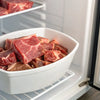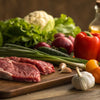Does Freezing Raw Dog Food Kill Bacteria? Exploring Safety and Best Practices for Pet Owners
- Houndsy
Table of Contents
- Introduction
- Understanding Raw Dog Food and the Risks Involved
- The Science Behind Freezing Raw Dog Food
- Best Practices for Storing and Handling Raw Dog Food
- Pros and Cons of Freezing Raw Dog Food
- Conclusion
Introduction
Imagine a scenario: you've just returned home from picking up a fresh batch of raw dog food, excited about providing your furry friend with what many claim is a more natural and nutritious diet. But as you move to prepare your pup's meal, a burning question arises in your mind: does freezing raw dog food kill bacteria? This simple yet profound question encapsulates a crucial aspect of pet ownership that many dog lovers grapple with.
With an increasing number of pet owners opting for raw meat-based diets (RMBDs), understanding the implications of freezing these foods is more important than ever. While the appeal of such diets often lies in the promise of improved health and vitality for our pets, they come with inherent risks, notably the potential for harmful bacterial contamination. A recent study noted that around 15% to 25% of dog owners now incorporate some form of raw diet into their pets’ meals. However, to keep our pets and families safe, we need to fully understand the challenges involved, particularly when it comes to handling raw ingredients.
In this blog post, we aim to unravel the complexities of freezing raw dog food. We will dive into the science behind bacterial survival in frozen environments, address best practices for safely handling raw dog food, and discuss how freezing interacts with both pathogens and nutritional quality. By the end, you will be equipped with valuable insights that can help you make informed choices about your beloved pet's diet while keeping their wellbeing—and yours—in mind.
Understanding Raw Dog Food and the Risks Involved
What is Raw Dog Food?
Raw dog food typically includes uncooked meats, organs, bones, and sometimes fruits and vegetables. This unprocessed form of pet nutrition aims to mimic what a dog might consume in the wild. However, while raw diets have gained popularity for their perceived health benefits, they also pose specific risks related to foodborne illnesses caused by harmful bacteria.
The Risks of Bacterial Contamination
The primary concern surrounding raw dog food is the potential for contamination with pathogenic bacteria. According to veterinary studies, common bacteria like Salmonella, E. coli, and Listeria can be present in raw meats. These pathogens primarily come from the animal's intestinal tract and can pose serious health risks—not just to those consuming the food but also to humans who come into contact with it.
-
Salmonella: This pathogen can lead to gastrointestinal illness in both dogs and humans, often manifesting as severe diarrhea, fever, and vomiting. It is particularly concerning for vulnerable populations such as young children, the elderly, and immunocompromised individuals.
-
E. coli: Some strains of E. coli are known to carry antibiotic-resistant genes, thus posing risks to both pets and their owners.
-
Listeria and Campylobacter: These bacteria can lead to severe illnesses and are particularly dangerous for pregnant women.
Should You Freeze Raw Dog Food?
While freezing may not eliminate these bacteria, it plays a vital role in slowing their growth. However, understanding the limitations of freezing and recognizing that it doesn't kill all pathogens is crucial for any dog owner considering this feeding method.
Anecdotal Claims vs. Scientific Evidence
Many pet owners report improvements in conditions such as skin health, coat shininess, and digestion after switching to a raw diet. Although anecdotal evidence speaks volumes, scientific research is less conclusive. Peer-reviewed studies supporting these benefits remain sparse, urging pet owners to cautiously weigh risks against potential advantages.
The Science Behind Freezing Raw Dog Food
Freezing and Bacterial Survival
When subjected to freezing temperatures, bacteria enter a dormant state rather than being killed outright. Resilient microorganisms can withstand freezing, potentially resuming their metabolic activity once the meat is thawed. This is particularly true for notorious pathogens like Salmonella and E. coli.
-
Bacterial Dormancy: Freezing at 0°F (-18°C) or lower effectively halts the growth of harmful bacteria and pathogens without necessarily destroying them.
-
Understanding Thawing Risks: Once thawed, the risk of bacterial growth increases significantly, especially if the food is left at room temperature for extended periods. Thus, handling thawed raw dog food requires strict hygiene protocols.
The Role of Temperature
Scientific studies support the premise that freezing raw meats slows bacterial growth significantly, making it a valuable storage method. For instance, research indicates that freezing raw meat can lower overall bacterial counts when done properly, thus offering a safer feeding option for our pets.
Best Practices for Storing and Handling Raw Dog Food
Freezing Guidelines
For dog owners opting for raw diets, understanding safe food handling practices is imperative to minimize health risks:
-
Freezing Before Feeding: Store raw dog food in the freezer until you're ready to feed. When purchasing raw meat, aim to freeze it at -18°C or lower for at least 3-5 days. This can significantly reduce bacterial loads, making it safer for your pet to consume once thawed.
-
Thawing Correctly: Defrost raw meat in the refrigerator rather than at room temperature. This helps maintain a constant and safe temperature, reducing the risk of bacterial proliferation during the thawing process.
-
Avoid Refreezing: Once meat is thawed, do not refreeze it. Discard any uneaten portions to avoid potential bacterial growth.
Hygiene Practices
Maintaining a clean environment is essential when handling raw dog food:
-
Thorough Handwashing: Always wash your hands with warm, soapy water after handling raw meat to prevent cross-contamination.
-
Sanitize Surfaces: Clean countertops and feeding areas thoroughly after preparing meals for your pet.
-
Separate Storage: Store raw dog food away from other groceries to avoid cross-contamination.
- Use Leak-Proof Containers: Especially when thawing, ensure you are using leak-proof containers to prevent any drips that may contaminate other surfaces.
Choosing Quality Raw Food Suppliers
Opting for reputable suppliers can greatly reduce health risks associated with raw dog food. Look for brands that:
-
Use high-quality, independently tested ingredients. This ensures that the product has undergone rigorous safety checks to minimize pathogenic contamination.
-
Implement safety measures. Many quality raw food manufacturers utilize processes like high-pressure pasteurization (HPP) or irradiation to effectively neutralize harmful pathogens while preserving nutritional integrity.
Pros and Cons of Freezing Raw Dog Food
Pros
-
Extended Shelf Life: Freezing allows you to store raw ingredients longer without spoilage.
-
Slowed Bacterial Growth: Properly frozen food can significantly reduce bacteria levels, reducing health risks when handled correctly.
-
Nutritional Retention: Freezing helps preserve the nutritional benefits inherent in raw meats, fruits, and vegetables.
Cons
-
Residual Risks: Freezing does not kill all bacteria; it merely slows their activity, compelling owners to maintain vigilant hygiene and food handling practices.
-
Cost: High-quality raw products can be more expensive than traditional kibble or canned options.
-
Digestive Adaptation: Switching to raw or frozen diets must be gradual, as sudden changes can disrupt your dog's digestive balance.
Conclusion
The questions surrounding the safety and efficacy of freezing raw dog food highlight important considerations for responsible pet ownership. While freezing is an effective way to limit bacterial growth and extend meat's shelf life, it is not a foolproof method for eliminating risks. It is essential to prioritize safe handling practices, choose quality suppliers, and remain informed about the implications of raw feeding.
By equipping ourselves with knowledge and adopting the right practices, we can enjoy the process of feeding our dogs a natural diet that aligns with their health needs. And while exploring options for feeding routines, we invite you to discover our innovative solutions at Houndsy, including our flagship Houndsy Kibble Dispenser, designed to elevate the feeding experience in terms of convenience, style, and portion control. Make mealtime a pleasure for both you and your dog by clicking here: Houndsy Kibble Dispenser.
FAQ
-
Does freezing raw dog food eliminate all bacteria?
- No, freezing slows bacteria growth but does not kill them. Bacteria like Salmonella and E. coli can survive freezing and can become active again once the food is thawed.
-
What is the best way to thaw frozen raw dog food?
- Thaw raw dog food in the refrigerator to maintain a safe temperature and prevent bacterial growth.
-
Is it safe to refreeze raw dog food after it has been thawed?
- No, once thawed, raw dog food should not be refrozen. Dispose of any uneaten portions to minimize risks.
-
How can I reduce the risk of bacterial contamination when feeding raw diets?
- Follow proper hygiene practices such as washing hands and surfaces, using separate storage for pet food, and sourcing from reputable suppliers.
-
Are there benefits to feeding a raw diet to dogs?
- Many dog owners report improved coat condition, enhanced vitality, and better digestion when feeding raw diets. However, scientific evidence supporting these benefits is limited, so it's essential to do thorough research.
By being mindful of these practices and remaining informed, we can navigate the complex landscape of pet nutrition effectively, ensuring a safe and enriching experience for our canine companions.












